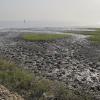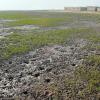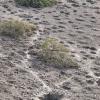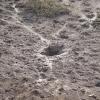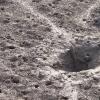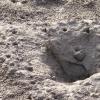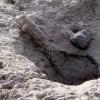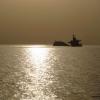Mudflats and Mudskippers in Warba
Mudflats in Warba on the Mesopotamian Delta. Feuturing the unique Mudskipper that lives his life in both worlds!
By Nancy Papathanasopoulou
First published in the Arab Times October 25, 2011
With the superficial looks of astrange lizard sliding in the mud or jumping up to two feet when there is a reason for it, the mudskipper is called "Bushalambo" in Arabic. The lazy one. Local culture is making a point, stating that, even though all other marine animals follow the waters of the tide as they withdraw and return, this particular one lingers behind and lives life in both worlds.
On a boat trip to Warba, the northmost shore of Kuwait onthe border with Iraq, we encountered a lot of them. Unable to identify which ones of the four species living in Kuwait we were looking at, as the sun was setting and light was getting scarce, we just sat there and enjoyed their busy movements, their slithering bodies in the nutritious mud of the Shatt Al-Arab, recalling a few interesting facts about them, which many people may not be aware of.
Mudskippers belong to the family of gobies. They are capable of breathing air thanks to a bubble that they retain in their gill chambers. They can also breathe through their skin if it’s wet. And their habitat is somewhere between land and sea. It is, in fact, the fertile mud, the intertidal mudflats, which is the most nutritious environment in nature. Unlike other living organisms, evolutionary process did not result to the choice of one element or another for these ones. They live inbetween, no matter whether their deep burrows are covered by the tide or not.
These fish, which are, in fact, gobies, use their fins to move vigorously in a series of skips. They are also able to catapult themselves up to more than half a meter into the air, in an effort to impress members of the opposite sex or competitors in defense of food and territory. They have eyes at the top of the head for an all-round view, while their mouth faces downwards to feed continouously on the mudsurface.
They dig deep burrows in softsediments that allow the fish tothermo regulate, avoid marinepredators during the high tide when both fish and burrow are submerged and for laying their eggs. Eggs are laid in a sealed pocket of air in the burrow and the father makes endless trips to the surface to renew the air, inhaling a bubble and exhaling it in the air pocket of the nest where the eggs are laid.
The mud is very good for burrowing in, since conditions are very sticky, unlike sand. Burrows will usually last for quite a long time.
Some sport a little chimney sticking up above the surface, others have small water-filled pools beside the openings, and the reason for these variations is still unknown to science.
Under certain conditions, a single fish of the species Boleophthalmus boddarti build polygonal territories of a size of about one meter, surrounded by dams, defended against rivals, and large enough to provide food. It also builds walls for protection from all sorts of invaders. Members of this species build and maintain these polygonal walled territories by carrying mouthfuls of mud from their burrows and depositing them on their walls. The burrow may be anywhere in the territory, maybe right beside the wall. This wall-building behavior was for along time believed to be unique for this species in Kuwait’s Suleibikhat Bay but it was recently observed in Iran as well.
Mudflats and intertidal zones have always been considered "slimy" and "dirty". As such, it seems "no harm" to litter them continuously, with little regret. Apart, however, from the wondrous mudskipper, thousands of birds, fish, crabs, shrimp and a very large number of other living creatures call these areas their home and depend on their pristine condition to survive. Upon a next visit, a careful, close look may be a revelation, regarding this natural element, which without doubt deserves the utmost national pride.

